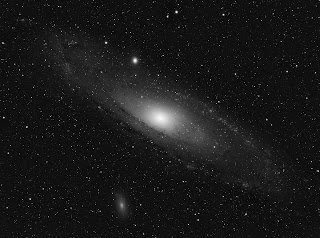There are a couple of big differences from my image of three years ago, 1) in this new image I framed it 25 degrees off the declination line so I could get entire galaxy, 2) in addition to collecting LRGB data, I also collected Ha data as I wanted show regions of nebulosity. I did manage to combine the Ha data into the LRGB image in PI but it was not as easy as combining nebula images. It was a trial and error approach as PI has many different options for combining images and I had to try many different methods before I found one that worked okay.
The final image is an improvement over my original, however, I wish it were a little more detailed. I do like the star field and the two satellite galaxies M110 and M32 both are resolved. I think had I gotten more RGB data and luminosity on a clearer night would have improved the quality. Waiting perfect nights to image in NE is few and far between. I did successfully add the Ha data and all of the small red areas located on the spiral arms around the edges are regions of high Ha activity or nebulae. These are areas where star formation is taking place. If we were in Andromeda looking at the Milky Way I imagine we would see something similar.
More learning:
I have been using APT for well over six months now as my main camera controller and have been liking everything about it except the focusing. I used BYEOS to focus when I still had the DSLR as the FWHM did not jump around nearly as much as it does with APT. When I got the ZWO ASI1600 BYEOS was not an option. I purchased a a Bahtinov mask which worked well with SGP as it gave a nice big view to adjust but APT gave me this barely visible view. I also could not see nebulae or other things to check the framing. I knew I must be missing something as I can't believe so many AP use this program. Finally, I pressed the log scale button to give the maximum exposure and eureka - I the star spikes are clearly visible and so are nebulae. Yes, I feel like an idiot which makes me the perfect person to write or make the Idiots Guide to APT youtube videos.
HaRGB
Ha
Luninosity
M31 - Andromeda Galaxy HaRGB
Location: Home Monroe, CT
Date: 9-28-18, 9-29-18, 10-3-18, 10-4-18, 10-13-18, 10-14-18
Camera: ZWO ASI1600MM-Pro
Telescope: Orion ED80 80mm f/7.5 Apochromatic Refractor Telescope
Barlow: None
Focal Length: 600mm
f/7.5
Focal Reducer: Orion 0.8x Focal Reducer for Refractor Telescopes
Mount: Orion Sirius EQ
Filter Wheel: ZWO EFW 8x 1.25"
Filter: ZWO Ha, L, R, G, B
Autoguiding: QHY-5L-II-M attached to an Agena 50mm Guide Scope with Helical Focuser
Exposure: Ha 40 x 180s, L 60 x 60s, R 39 x 60, G 34 x 60, 36 x 60
Gain: 139
Offset 21
Temp: -10 C
Post Processing: PixInsight and Photoshop
https://kurtzeppetello.smugmug.com/
Date: 9-28-18, 9-29-18, 10-3-18, 10-4-18, 10-13-18, 10-14-18
Camera: ZWO ASI1600MM-Pro
Telescope: Orion ED80 80mm f/7.5 Apochromatic Refractor Telescope
Barlow: None
Focal Length: 600mm
f/7.5
Focal Reducer: Orion 0.8x Focal Reducer for Refractor Telescopes
Mount: Orion Sirius EQ
Filter Wheel: ZWO EFW 8x 1.25"
Filter: ZWO Ha, L, R, G, B
Autoguiding: QHY-5L-II-M attached to an Agena 50mm Guide Scope with Helical Focuser
Exposure: Ha 40 x 180s, L 60 x 60s, R 39 x 60, G 34 x 60, 36 x 60
Gain: 139
Offset 21
Temp: -10 C
Post Processing: PixInsight and Photoshop
https://kurtzeppetello.smugmug.com/





